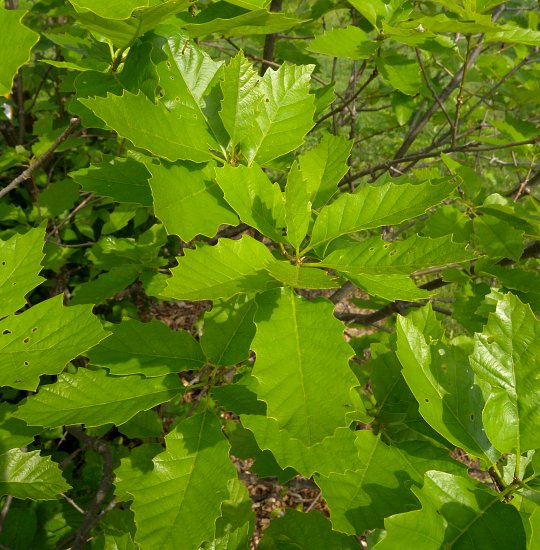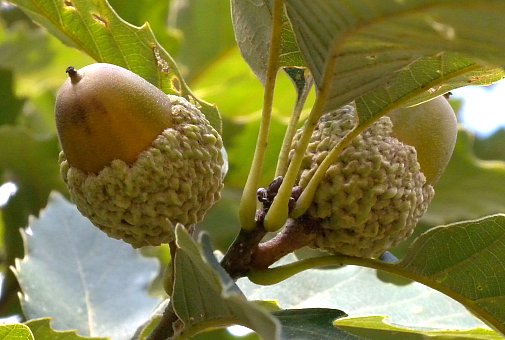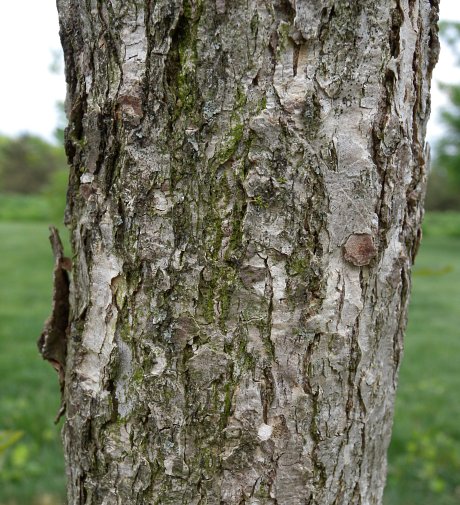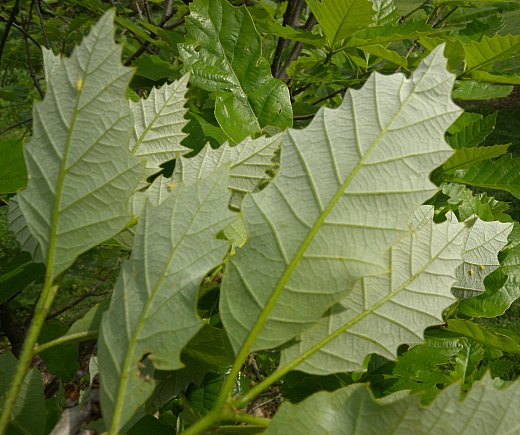
Like other oaks (Quercus spp.), this oak is monoecious with separate male (staminate) and female (pistillate) flowers on the same tree. Male flowers occur in drooping catkins near the bases of young shoots; these catkins are 1–2½" long, narrowly cylindrical in shape, and yellowish green. Male flowers have 4-6 stamens each. Either solitary or clusters of 2-3 female flowers occur near the tips of young shoots; they are green to reddish green and inconspicuous. The blooming period occurs from mid- to late spring, lasting about 1-2 weeks. Cross-pollination occurs by wind. Afterwards, fertile female flowers develop into acorns that become mature during the autumn of the same year. Mature acorns are ½–¾" long and ovoid in shape; the cap of each acorn extends to about one-third of the length of the nut. The cap is tan-colored and densely warty in appearance, while the nut exterior is brown to dark brown and smooth. The starchy meat of the acorn is white, relatively stiff in texture, and slightly bitter. The root system consists of a taproot with well-developed lateral roots; it extends up to 6' into the ground. Sometimes this oak produces clonal offsets from underground runners.

Cultivation: The preference is full sun, mesic to dry conditions, and an acidic barren soil containing sand or rocky material. This oak can produce acorns at a young age when it is only 3-6' tall. It is not difficult to cultivate in loamy garden soil, although its size may become larger than what normally occurs in the wild. Some local ecotypes of this oak are winter-hardy to Zone 4 or Zone 5.
Range & Habitat: There are no reliable records of Dwarf Chinkapin Oak occurring in Illinois as either a wild or naturalized plant (see Distribution Map). Because of its similarity to saplings of the larger Chinkapin Oak (Quercus muhlenbergii), the presence of this oak may have been overlooked in Illinois, however. Dwarf Chinkapin Oak has an unusual disjunct distribution that is divided between the Ozark Mountains (including Arkansas and Missouri) and the Appalachian Mountains, where the eastern side of the distribution extends into sandy regions of the NE United States. Habitats include sand prairies, pine barrens, rocky glades, exposed ridges, and upland rocky savannas. Dwarf Chinkapin Oak is associated with natural areas that have acidic bedrock near the surface of the ground (e.g., sandstone, chert, or shale), or it is found in acidic sandy areas. It is not able to tolerate much competition from taller canopy trees.

Faunal Associations: The Obscure Scale (Melanaspis obscura) has been found on the bark of Dwarf Chinkapin Oak (Quercus prinoides), while larvae of the Round Bullet Gall Wasp (Disholcaspis quercusglobulus) form galls on the branches of this oak and larvae of other gall wasps (Cynipidae) form galls on its buds (ScaleNet, 2014; Bassett, 1881). Other insects that are known to feed on oaks (Quercus spp.) generally include larvae of wood-boring beetles (Buprestidae, Cerambycidae, Scolytidae), acorn-eating larvae of weevils (Curculio spp.), other weevils (Curculionidae), leaf beetles (Chrysomelidae), larvae of gall flies (Cecidomyiidae), plant bugs (Miridae), stink bugs (Pentatomidae), lace bugs (Tingidae), aphids (Aphididae), leafhoppers (Cicadellidae), treehoppers (Membracidae), mealybugs (Pseudococcidae), larvae of sawflies (Tenthredinidae), larvae of skippers (Erynnis spp.), and larvae of many moths, include tiger moths (Arctiidae), Geometer moths (Geometridae), leaf-miner moths (Gracillariidae, Nepticulidae, Tischeriidae), slug moths (Limacodidae), owlet moths (Noctuidae), silk moths (Saturniidae), and Tortrix moths (Tortricidae). The acorns of oaks (especially the smaller ones) are eaten by many kinds of upland gamebirds and other birds, including the Wild Turkey, Bobwhite Quail, American Crow, Red-headed Woodpecker, Red-bellied Woodpecker, Common Grackle, Blue Jay, White-breasted Nuthatch, Tufted Titmouse, and Eastern Towhee (Martin et al., 1951/1961). Such mammals as the Black Bear, Gray Fox, Red Fox, Opossum, Raccoon, Fox Squirrel, Gray Squirrel, Red Squirrel, Eastern Chipmunk, White-footed Mouse, and White-tailed Deer also feed on acorns. White-tailed Deer also browse on the twigs and foliage of these trees, while the Cottontail Rabbit gnaws on the bark of saplings during the winter. Because of its small size, the Dwarf Chinkapin Oak provides cover and nesting habitat for the Prairie Warbler and other songbirds.

Photographic Location: The Arboretum of the University of Illinois in Urbana, Illinois.
Comments: This is one of a few species of oaks (Quercus spp.) that remain small in size (less than 20' tall), and the Dwarf Chinkapin Oak (Quercus prinoides) is one of them that can be cultivated in Illinois. This small oak can be distinguished from saplings of the larger Chinkapin Oak (Quercus muhlenbergii) by the appearance of its leaves: they have fewer pinnate lobes (typically 5-8 along each side) than the leaves of the latter oak (typically 10-15 lobes along each side). The leaves of Chinkapin Oak also tend to be more slender in shape and slightly longer in length (up to 7"). An alternative spelling of the common name for Quercus prinoides is Dwarf Chinquapin Oak.